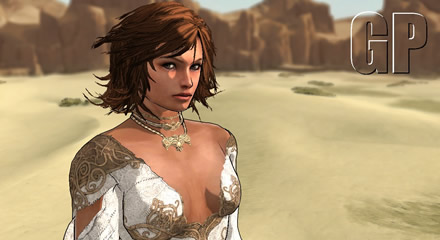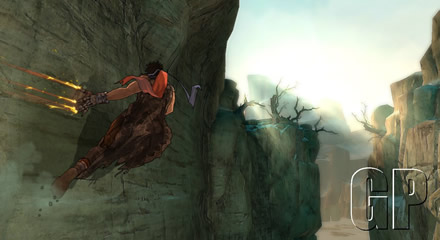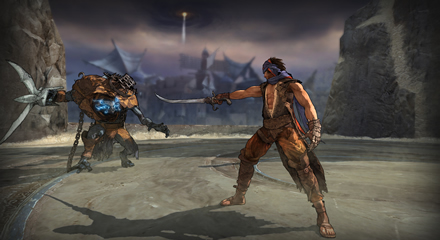Prince of Persia PS3 Reviewed

It’s getting awfully close to Christmas, so if you need things brief I’ll go right ahead and say that this is one of the best, if not the best, Prince of Persia titles in recent years. It simply is a must-buy game that puts a refreshing new spin on the series, bringing the protagonist Prince into expansive and breathtaking outdoor environments where he’s free to put Sly Raccoon to shame with his ape-like athletic ability. And it’s the first of a trilogy!
Oh and exercise his new found wit and the American accent inexplicably bestowed upon him despite his ancient Persian decent. Of course, we all know that Persians are nine feet tall and laced with gold jewellery so we’ll just consider him to be a misplaced, sword-wielding free runner.
But, I digress. If you’re considering it, buy it. If you’re not considering it, consider it, then buy it. It’s that simple.
It’s also exceptionally easy going, but still challenging. These are two statements would ordinarily seem at odds with each other, but Prince of Persia removes a great deal of frustration which might turn the casual gamer away from such a gorgeous title without detracting from the challenge of leaping from object to object, solving puzzles and defeating vicious enemies.

Right from the outset of the game you’re joined by an female companion who drives forward the plot.
In short, you can’t die. You’ll never see a game over screen. You’ll never plummet to your death. And you’ll never be killed by an enemy. Bosses seem to take this same liberty, fleeing constantly from combat at the brink of their defeat but always turning up again for some more princely behind-whooping.
There’s a lot to say about Prince of Persia, so I think I’ll have to go back to the good old days and do a little GamingHeadlines style break down. Here goes:
Environments
The environments in Prince of Persia are absolutely mind-blowingly expansive, putting the likes of Tomb Raider underworld utterly to shame with their beauty and breadth. At the hub of the game world is a vast temple beneath a tree where, during certain cut scenes, you see desert and then mountains trailing off into the distance. The mind tricks you into thinking it’s a pre-rendered backdrop, and if you hadn’t just walked across it you might think it so. For what you may think a simple platformer, levels this vast and seamless are a surprising, impressive and welcome addition that go a long way toward drawing you into the game. Of course, the Assassins’ Creed engine is the driving force behind this expansiveness and has been put to beautiful use to make Prince of Persia, to a fair extent, non-linear and explorable.
Leave the controller untouched for long enough in the right place and the game will jump at the opportunity to cut away from your characters and show off a few slowly panning scenes from the surrounding landscape or architecture. These really demonstrate the stunning level of detail that you just can’t appreciate whilst playing the game. And it’s in this level of detail that the game shines, all the little touches you almost never notice such as the lush grass and plants in a newly restored area swaying gently in the wind. Plants even bow out of your way, releasing dandelion-like particles into the air as you pass, your gauntlet leaves scratches as you slide down a wall, foul air has a beautiful hanging particle effect and tendrils of darkness stretch out towards you., a somewhat eerie effect to say the least.
Almost everything the Prince can interact with to make his way through these vast levels is effectively blended in to the scenery itself. A slightly worn wall will often indicate a good spot to run, ivy is climbable and the prince can monkey his way effortlessly up ruined pillars, swing from metal rings and perform a generally impressive array of physically impossible gymnastics using his gauntlet extensively to slow falls down walls and bridge gaps between handholds.
Perhaps some of the detail makes it a little too obvious where you’re supposed to go, but it’s generally blended in well enough with the architecture or environment that you wont notice or mind.
Travelling
Get good enough at controlling the prince and you will find that executing chains of jumps, wall runs and other acrobatics becomes fluid and effortless with the prince’s positioning being handled for you. Try and slow down, however, and you’ll find yourself struggling with the sometimes pesky camera. It’s clear that obstacles are meant to be overcome as fast as possible and the game becomes all the more fun and exhilarating when you focus on speed. It’s also much less frustrating when you do go wrong and fall because you know that mistake is mere seconds of deft and accurate button presses away.
Speed is further emphasised because you’re often up against the clock, racing towards and enemy spawn point. If you’re fast and accurate you can get there in time and kill the enemy with a single hit before it fully spawns.
Plummeting to your death isn’t a problem, you don’t have silly things like lives, you don’t have a health meter, in fact there’s no UI whatsoever to break your absorption into the game. Should you miss a jump, or slip to your death then your beautiful female companion Eleka will use her magic to swoop down and whisk you to the nearest terra-firma. This harks back to the death cheating mechanic of Sands of Time, which is the last Prince of Persia game I invested any real time into, only you’ll be automatically rescued every single time and never have to face a “Game Over” screen.

When not being used in combat, the Prince’s Gauntlet adds to his forté of impossible moves.
As you progress through the game you will unlock Eleka’s special abilities which, unfortunately, can only be activated on certain coloured pads throughout the game. These abilities all focus on getting the Prince from A to B in various different ways, all but one of them are fun. The black sheep is the flight ability, which lays on far too many visual effects and challenges you to dodge obstacles in an on-rails flight sequence. If these sequences were a little more forgiving, and not so heavy on the effects then they would be a beautiful way of showcasing the vastness and beauty of the levels. As they are, however, they’re the single most frustrating component of the game.
If you ever manage to get lost you can call upon Eleka to highlight the way ahead with a glowing orb which will zip though the obstacles ahead and show you the path you should take. Once you get into an area everything gets fairly linear, it would be nice to have some alternate routes and a bit more opportunity for exploration, particularly as it’s possible to traverse one area to reach another. It would pay to have more incentive to travel on foot, instead of using the teleport system.
Earning the Explorer trophy is one such incentive, as are the progressively larger amounts of light seeds you must collect to earn trophies, but more secret areas and alternate routes would have been appreciated to keep completionists busy.
Combat
Combat is stunningly executed but takes a very large step away from that in previous Prince of Persia titles. Instead of engaging multiple enemies at a time within the game world, and using the scenery around you, you end up with a combo-laiden, beat-em-up style fight against a single enemy at a time. Perfectly integrated QTEs and button mashing events make battles against more powerful enemies a genuine test of reaction and endurance and allow for some spectacular looking, effects laden, moves. During fight scenes the camera work is almost pure perfection, zooming, panning and following you, your companion or your enemies every move depending on where the action is focussed.
Scenery usage is a little different, with you beating back enemies over the edges of platforms and using pillars to crush them.
It’s all made easy to learn by using a one-button-for-one-attack method, in addition to blocking of course, which you will need to use liberally to get the better of your opponents. You can attack with your sword, the metal gauntlet worn upon your left hand, your companion’s magic or pull off stunning acrobatic attacks. Chaining these together will allow you to achieve visually stunning combos that are as fluid as the best fighting games, and more effects laden than an overblown RPG spell sequence. Of course, it’s all in real-time so only onlookers will really have time to appreciate the splendour of it all. To truly appreciate how beautiful Prince of Persia is, you have to let someone else play for a while.

No screenshot will ever do the Prince of Persia combat justice, so this one doesn’t even try. Watch out for a video!
As forgiving as the inability to die might sound, battles with bosses late in the game are quite challenging and offer you the chance to hone your skills at chaining together attacks, remembering which attacks to use in which situations and mastering those button mashes and QTEs. Often, though, pushing an enemy back over the edge of a ledge is good way of beating them without entering a draw out fight and sometimes it’s absolutely necessary.
In lieu of you dying, however, your foe will regain health when you are saved by your companion. A fact that can get slightly frustrating if you’re utterly exhausted every available finger with frantic mashing of the square button.
The combat in Prince of Persia is, perhaps, more exhilarating than anything else I’ve experienced in a long while. It forces you away from constant button mashing and adds in different enemy phases and events to mix things up. It puts the buttonmashtastic antics of Soul Caliber and Dynasty Warriors to shame and brings on a wholly refreshing experience.
Puzzles
If there’s a weak point in Prince of Persia, puzzles are probably it. I’m not saying that they’re not slightly challenging and frequent enough. They just all seem to employ exactly the same mechanic of pushing great, big rotating levers in order to line things up or arrange things to allow you passage. They add a little break into the game and a little variation, but they also feel at odds with the rest of the beautifully blended and absorbing environment and ruin the otherwise immersive experience. Suffice to say, as soon as you run into a puzzle you’re back to reality and just playing a game again.
Story
With my other half being hopelessly and viciously addicted to Prince of Persia I have taken a somewhat back seat role to completing the game and watching events as they unfold. There is little in the way of a meandering, complex or engaging plot in Prince of Persia, it takes a much more Disney approach. You have clear cut villains, clear cut heroes, approximately as much character development as Pac Man and the odd little “ah-ha” moment where, perhaps, the story is setting up for events in the second addition to the trilogy. The ending is more of an epilogue that plays brilliantly upon the players emotions and may perhaps make you feel like you’ve driven the plot that little bit further of your own volition. Okay, it’s unsophisticated and wouldn’t win any awards for story telling. But it still manages to have us drooling for the second and third titles and hoping that, somehow, this new direction in which the much beloved and soon-to-be 20 year old Prince of Persia has been taken will survive, intact, in its sequels.
Overall, and probably because of my lack of interest in the previous spate of 3 Prince of Persia titles, I immediately fell in love with the re-imagined Prince of Persia. The vast, expansive environments continued to take my breath away throughout the game and the battles, whilst repetitive, are exhilarating and beautiful enough to remain enjoyable throughout the game.